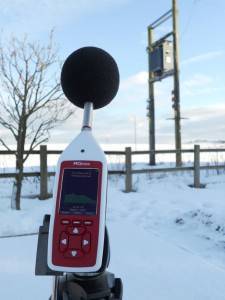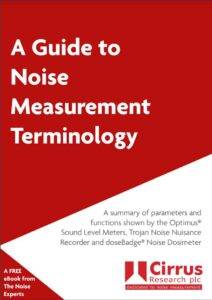Measuring Noise in the Snow – Does it Affect Your Noise Measurements?
With the recent cold snap that has hit the UK, Cirrus Research customers have raised a few questions about how wet weather and low temperatures could affect their noise measurements.
There are two situations surrounding the effects adverse weather has on noise measurements that can be looked at in more detail. The first is based on if you are using a handheld sound level meter in low temperatures and the second is if you are using an outdoor measurement kit, leaving your equipment outside in adverse weather conditions.
Temperature Effects on Sound Level Meters
Sound level meters that have been designed to meet the latest IEC 61672 Standard will have been tested across a range of temperatures. This standard specifies that the instrument should meet Class 1 or Class 2 (depending upon the instrument) over a temperature range of -10oC to +50oC.
Outside of this range, the instrument may be affected by temperature and you should be cautious about making measurements where the temperature is higher or lower than these values.
It is always worth checking with the manufacturer as to any possible effects that temperature may have upon the equipment.
At low temperatures, LCD displays will become sluggish and may appear to be blurred. This is due to the liquid crystal in the display starting to freeze and not being able to react quickly to signals from the instrument. The OLED type display used on the Cirrus Optimus is not affected in this way and can be used in very low temperatures with little effect.
The Effect of Temperature on Batteries
Batteries can also be affected by the temperature. Always be sure to fit a new set of batteries and keep a spare set handy just in case! As a rule of thumb, at temperatures below 0oC batteries may only provide about half their rated capacity.
Most, if not all, sound level meters are not completely waterproof and any moisture that gets inside the case can damage the electronics and cause the instrument to fail. Even if your instrument does not get snow or rain directly onto it, condensation may occur if your instrument is moved from a cold to a warm environment quickly. This can often happen if you’ve kept your instrument in the car overnight and then moved it to a warm place for calibration.
It’s always a good idea to let the instrument warm up to room temperature before calibrating it. Most modern acoustic calibrators, such as the Cirrus CR:515 and CR:514, have internal temperature compensation and so will adjust themselves to the ambient conditions. However, it’s always worth checking what, if any, adjustments you may need to make to the calibration level that you are going to use.
Outdoor Measurement Kits
If you are using an outdoor measurement kit such as the Cirrus CK:670 or CK:680 and your equipment is outside during adverse conditions, there are a few points that should be considered.
The sound level meter will probably be very well protected inside an enclosure or case that prevents it from being damaged or affected by the weather but, the outdoor microphone will be impacted by snow and rain.
The windshield that protects the microphone capsule can become water logged or covered in snow, both of which can significantly affect the frequency response of the system.
The windshields used on the CK:670 and CK:680 are coated in a special hydrophobic material which helps water run off the outside before it can be soaked into the foam , this significantly reduces the effect of a wet windshield.
Two of our engineers, Richard Wright and Guillaume Goulamhoussen, wrote a paper that they presented at Internoise 2011 in Osaka, Japan which covered some of the effects weather can have on outdoor microphone windshields.
In the tests carried out for this paper, windshields were sprayed with water to simulate rain. The windshield that was coated absorbed 4g of water whilst the uncoated absorbed 70g of water.
Another test involved accumulating ice on the windshield to simulate typical conditions where a measurement is being made in wet weather followed by low temperatures. A ‘crust’ of ice or snow on the windshield will produce significant variations in the response to sound waves from different directions, due to the hard surface absorbing or scattering sound waves. In this situation the only course of action is to inspect the windshield regularly, and gently remove the ice crust.
This paper can be downloaded in full from the Cirrus Research website using this link.
Jaymee-lee Tolliday
Latest posts by Jaymee-lee Tolliday (see all)
- Turning Down the Volume: How the Trojan Noise Nuisance Recorder can help create a quieter world - 13th February 2024
- Festive Opening Hours 2023 - 6th December 2023
- Award of Excellence for Cloud-Based Monitoring Solutions 2023! - 20th November 2023



